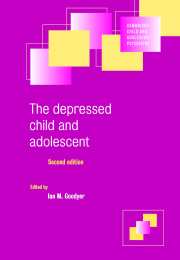Book contents
- Frontmatter
- Contents
- List of contributors
- Preface
- 1 Historical aspects of mood and its disorders in young people
- 2 The development of emotional intelligence
- 3 Developmental precursors of depression: the child and the social environment
- 4 Physiological processes and the development of childhood and adolescent depression
- 5 Childhood depression: clinical phenomenology and classification
- 6 The epidemiology of depression in children and adolescents
- 7 Family–genetic aspects of juvenile affective disorders
- 8 Life events: their nature and effects
- 9 Adolescent depression: neuroendocrine aspects
- 10 Suicidal behaviour in adolescents
- 11 Psychopharmacology of depressive states in childhood and adolescence
- 12 The psychotherapeutic management of major depressive and dysthymic disorders in childhood and adolescence: issues and prospects
- 13 Natural history of mood disorders in children and adolescents
- Index
5 - Childhood depression: clinical phenomenology and classification
Published online by Cambridge University Press: 18 December 2009
- Frontmatter
- Contents
- List of contributors
- Preface
- 1 Historical aspects of mood and its disorders in young people
- 2 The development of emotional intelligence
- 3 Developmental precursors of depression: the child and the social environment
- 4 Physiological processes and the development of childhood and adolescent depression
- 5 Childhood depression: clinical phenomenology and classification
- 6 The epidemiology of depression in children and adolescents
- 7 Family–genetic aspects of juvenile affective disorders
- 8 Life events: their nature and effects
- 9 Adolescent depression: neuroendocrine aspects
- 10 Suicidal behaviour in adolescents
- 11 Psychopharmacology of depressive states in childhood and adolescence
- 12 The psychotherapeutic management of major depressive and dysthymic disorders in childhood and adolescence: issues and prospects
- 13 Natural history of mood disorders in children and adolescents
- Index
Summary
The concept of depression in childhood
Contribution of adult psychiatry to the concept of depression in childhood
Research into the nature and characteristics of depression in adults has provided an important framework for wider investigations of depression. In a clinical sense, the term ‘depression’ denotes an illness characterized by a change in mood that is persistent and sufficiently severe for it to be labelled a disorder. In adult psychiatry, much research attention has focused on the classification of depression. Two major distinctions have emerged: first, between bipolar and unipolar affective disorders and second, between psychotic (or endogenous) and neurotic (or reactive) depression (Paykel & Priest, 1992; Ramana & Paykel, 1992).
Using multivariate analysis methods, the Newcastle school asserted that two separate depressive syndromes could be distinguished in adult patients: neurotic (reactive) and psychotic (endogenous) (Kiloh & Garside, 1963; Carney et al., 1965). The distinctions within unipolar depression have not been replicated (Kendell, 1968, 1975). The term ‘endogenous’ has, however, come to reflect, clinically, a more severe and persistent depressive disorder, possibly unrelated to environmental adversities (diagnostic criteria include somatic symptoms of anorexia or weight loss; insomnia; early-morning wakening; diurnal variation of mood; severe guilt; hopelessness and psychomotor retardation or agitation; Ramana & Paykel, 1992). By contrast, neurotic or reactive depression is considered clinically to be a milder disorder and possibly reactive to environmental adversities (accompanied by anxiety, initial insomnia, self-pity rather than self-blame, and complaints of anorexia rather than complaints of weight loss; Ramana & Paykel, 1992).
Keywords
- Type
- Chapter
- Information
- The Depressed Child and Adolescent , pp. 119 - 142Publisher: Cambridge University PressPrint publication year: 2001
- 2
- Cited by



